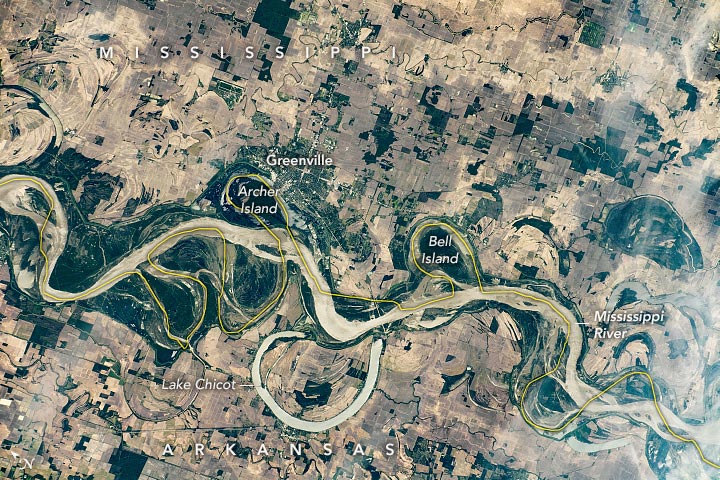
The winding Mississippi River historically has been used to define many state lines in the United States. This photo, taken by an astronaut onboard the International Space Station (ISS), has been annotated to show the current state boundary (yellow line) between Arkansas and Mississippi. (Note that north is to the left in this image.)
As the Mississippi River meanders over time, the channels migrate across the floodplain. Due to these changes in the position of the channel, some farms, towns, and rural lands occasionally switch to the opposite banks of the river. For instance, Archer and Bell Islands are still official parts of Arkansas, but they are now located east of the Mississippi River.
Sunglint reflects off of the water surfaces, outlining the banks of the river and likely differentiating turbulent surface flow from slower moving water. Over thousands of years, the turbulent meandering of the river has transformed the floodplain, creating oxbow lakes and cutting new channels into the surrounding landscape. Lake Chicot is considered the largest oxbow lake in the United States, spanning 5,300 acres (2,145 hectares). In the photo, sunglint on the lake has a glossier appearance than the river, potentially due to less disturbance of the water surface.
The Mississippi River Basin is home to many small towns and cities and a variety of agricultural activities. Nutrient-rich soil from sediment deposits throughout the floodplain supports productive cropland close to the river and its tributaries. In this photo taken during planting season, the farms are mostly distinguished by tan-brown rectangular fields, which will turn green as summer crops grow. Farming of cotton, corn, soybeans, and sweet potatoes makes up a significant portion of this area’s economic production.
Life along the Mississippi River has its hazards, particularly flooding. Greenville and other nearby cities were almost completely submerged during the “Great Flood of 1927.” As recently as this winter, seasonal flooding took a toll on this area. To mitigate these risks, the U.S. Department of Agriculture, Army Corps of Engineers, and other agencies regularly monitor river levels, weather, and crop-growing conditions to help farmers to plan for the growing seasons and floods.
Astronaut photograph ISS062-E-121160 was acquired on April 2, 2020, with a Nikon D5 digital camera using a 240 millimeter lens and is provided by the ISS Crew Earth Observations Facility and the Earth Science and Remote Sensing Unit, Johnson Space Center. The image was taken by a member of the Expedition 62 crew. The image has been cropped and enhanced to improve contrast, and lens artifacts have been removed. The International Space Station Program supports the laboratory as part of the ISS National Lab to help astronauts take pictures of Earth that will be of the greatest value to scientists and the public, and to make those images freely available on the Internet. Additional images taken by astronauts and cosmonauts can be viewed at the NASA/JSC Gateway to Astronaut Photography of Earth. Caption by Sara Schmidt, GeoControl Systems, and Alex Stoken, Jacobs, JETS Contract at NASA-JSC.
3 Comments
The river doesn’t obey human laws, of course.
The river hasn’t meandered since the 1940’s. The Army Corps Mat Sinking Unit armors the banks with concrete mats to prevent “meandering”.
Yes the state boundaries are wonky but it’s not from anything happening now.
What? you mean the Mississippi River does not respect state boundaries? Time to arrest it? Mother Natures answer: Try me, remember I bat in the last inning.